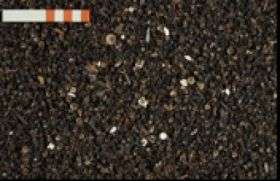Part of the fishbones from 1m2 of the Maglemosegaard excavation. 48 percent of the 12,784 identified fish bones were from gadids, mainly cod. Each red bar segment on the scale is 1 cm. Credit: G. Brovad
Scientists studying ancient fish bones in Scandinavia have discovered that warm-water species like anchovies and black sea bream that once thrived in Danish waters during a prehistoric warm period are now returning. Some cold-water species, such as cod, were also abundant during this period, having benefited from a lower fishing effort.
Through the study of archaeological material, tax accounts, church registers and account books of monasteries, an international group of fisheries ecologists and fisheries/maritime historians have drawn a picture of marine life in the northern European seas (North Sea, Wadden Sea, Baltic Sea, and White Sea) as it looked in the past.
Their findings are presented in a special issue of Fisheries Research “History of Marine Animal Populations and their Exploitation in Northern Europe, ” 14 papers starting from ca. 7000 BC to present. The volume is edited by Henn Ojaveer and Brian R. MacKenzie.
New historical documentation is increasingly becoming available. Its interpretation is providing a broader basis for understanding processes and mechanisms that lead to variations in marine populations and ecosystems. The studies in this special issue are important contributions to the establishment of new baselines for management of marine ecosystems including conservation strategies for overexploited living resources. They were conducted under the auspices (or as part of) the History of Marine Animal Populations, a project of the international collaboration, the Census of Marine Life.
Fisheries Research “History of Marine Animal Populations and their Exploitation in Northern Europe Volume 87, Issues 2-3, Pages 101-262 (November 2007) http://www.sciencedirect.com/science/journal/01657836.
Source: Census of Marine Life
























